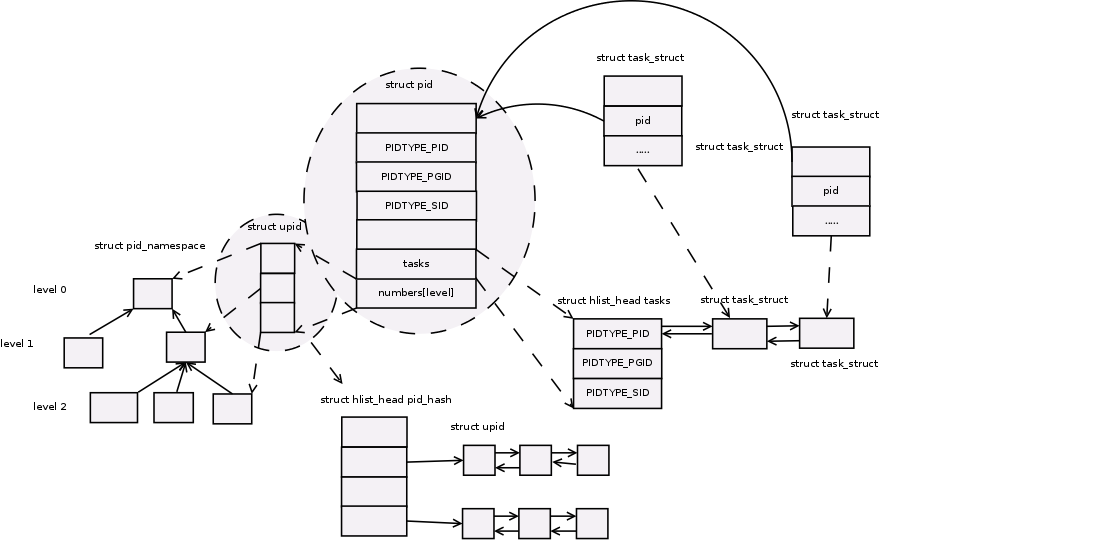一、背景
在AMD64平台下,可用的线性地址空间远远大于目前安装的RAM大小,所以在这种体系中,ZONE_HIGHMEM总是空的。
而在32位平台上,Linux设计者必须找到一种方式允许内核使用所有4GB的RAM,如果IA32支持PAE的话,则使内核可以支持64GB的RAM。
IA32架构下,之所以有这些约束,主要是为了兼容前代固有的硬件架构(i386),例如DMA直接读取,i386 内存大于900MB的情况。
ZONE_HIGHMEM属于高于896MB的内存区域,需要通过高端内存页框分配的方式映射到内核线性地址空间,从而使得内核可以对高端内存进行访问。而低于896MB直接通过(PAGE_OFFSET)偏移映射到物理内存上。详细查看http://www.lizhaozhong.info/archives/1193
二、原理
高端内存页框分配alloc_pages()函数返回的是page frame 页描述符(page description)的线性地址,因为这些页描述符地址一旦被分配,便不再改变,所以他是全局唯一的。这些页描述符在free_area_init_nodes()初始化时,已建立好。
注:free_area_init_nodes()之前的初始化与体系结构相关,当系统调用这个函数后,开始初始化每个pg_data_t的结构体,便于体系结构再无相关,http://lxr.free-electrons.com/source/mm/page_alloc.c#L5386。。
页描述符我们可以想象成系统将所有内存按照4k等分划分形成的数组下标。所有的page descriptor组成一个大的连续的数组 ,每个节点起始地址存放在 struct page *node_mem_map中,因此如果知道了page descriptor的地址pd,pd-node_mem_map就得到了pd是哪个page frame的描述符,也可以知道这个页描述符是否高于896MB。
已知alloc_pages()函数分配一个page descriptor的线性地址,可由它得到它所描述的物理页是整个内存的第几页:
假设是第N个物理页,那么这个物理页的物理地址是physAddr = N << PAGE_SHIFT ,一般情况PAGE_SHIFT 为12 也就是4k。在得知该物理页的物理地址是physAddr后,就可以视physAddr的大小得到它的虚拟地址,然后对这个虚拟地址进行判断:
1.physAddr < 896M 对应虚拟地址是 physAddr + PAGE_OFFSET (PAGE_OFFSET=3G)
2.physAddr >= 896M 对应虚拟地址不是静态映射的,通过内核的高端虚拟地址映射得到一个虚拟地址(也就是内核页表映射)。
在得到该页的虚拟地址之后,内核就可以正常访问这个物理页了。
所以,我们可以将physAddr高于896M的这128M看做成为一个内核页表,这个内核页表在paging_init()初始化完成。
三、实现
内核采取三种不同的机制将page frame映射到高端内存:永久内核映射、临时内核映射、非连续内存分配。
alloc_page()函数集返回的是全是struct page* 类型的数据,返回的也都是page descriptor的线性地址。然后系统要判断该page descriptor是否是highmem,也就是void *kmap(struct page *page)
http://lxr.free-electrons.com/source/arch/x86/mm/highmem_32.c#L6 。
系统调用PageHighMem(page),判断当前page是否是highmem,如果是返回kmap_high(page)。如果不是返回page_address(page) http://lxr.free-electrons.com/source/mm/highmem.c#L412
void *kmap(struct page *page)
{
might_sleep();
if (!PageHighMem(page))
return page_address(page);
return kmap_high(page);
}
void *page_address(const struct page *page)
{
unsigned long flags;
void *ret;
struct page_address_slot *pas;
if (!PageHighMem(page))
return lowmem_page_address(page);
pas = page_slot(page);
ret = NULL;
spin_lock_irqsave(&pas->lock, flags);
if (!list_empty(&pas->lh)) {
struct page_address_map *pam;
list_for_each_entry(pam, &pas->lh, list) {
if (pam->page == page) {
ret = pam->virtual;
goto done;
}
}
}
done:
spin_unlock_irqrestore(&pas->lock, flags);
return ret;
}
在page_address()函数中,我们要再次检查该page是否属于HIGHMEM,如果不属于,则直接计算偏移量__va(PFN_PHYS(page_to_pfn(page)))。
而pas = page_slot(page);之后的代码,是在永久映射中,系统为了方便查找,建立了一个page_address_htable散列表,系统可以很快的对于已经存放在散列表中的永久映射的page descriptor的线性地址进行查找,如果找到就返回内核线性地址,否则为NULL。
如果判断该page属于HIGHMEM,进入kmap_high(page) http://lxr.free-electrons.com/source/mm/highmem.c#L279
void *kmap_high(struct page *page)
{
unsigned long vaddr;
/*
* For highmem pages, we can't trust "virtual" until
* after we have the lock.
*/
lock_kmap();
vaddr = (unsigned long)page_address(page);
if (!vaddr)
vaddr = map_new_virtual(page);
pkmap_count[PKMAP_NR(vaddr)]++;
BUG_ON(pkmap_count[PKMAP_NR(vaddr)] < 2);
unlock_kmap();
return (void*) vaddr;
}
虽然判断了HIGHMEM,调用这个函数,但是我们不能信任,仍需要再次检查,顺便检查是否在page_address_htable散列表中存在该page,如果不存在,则进行映射( map_new_virtual(page)),然后将pkmap_count数组中,这个page引用+1,然会内核就可以正常使用这个高端内存的线性地址了。
map_new_virtual()函数是进行HIGHMEM映射的核心函数,其中for(;;)循环是寻找可用的内核页表项进行高端内存页框映射,这里涉及到了页表color问题,主要为了提速查找效率。
当系统找到可用的页表项时,从line261~line268就是核心
- 以PKMAP_BASE为基址last_pkmap_nr为偏移在永久映射区创建内核线性地址vaddr
- 将vaddr加入pkmap_page_table
- 引用赋值为1,之后有可能会++
- 然后将该内核线性地址vaddr加入page,并返回内核线性地址
</pre>
<pre>217 static inline unsigned long map_new_virtual(struct page *page)
218 {
...
224 start:
225 count = get_pkmap_entries_count(color);
226 /* Find an empty entry */
227 for (;;) {
228 last_pkmap_nr = get_next_pkmap_nr(color);
229 if (no_more_pkmaps(last_pkmap_nr, color)) {
230 flush_all_zero_pkmaps();
231 count = get_pkmap_entries_count(color);
232 }
233 if (!pkmap_count[last_pkmap_nr])
234 break; /* Found a usable entry */
235 if (--count)
236 continue;
237
238 /*
239 * Sleep for somebody else to unmap their entries
240 */
241 {
242 DECLARE_WAITQUEUE(wait, current);
243 wait_queue_head_t *pkmap_map_wait =
244 get_pkmap_wait_queue_head(color);
246 __set_current_state(TASK_UNINTERRUPTIBLE);
247 add_wait_queue(pkmap_map_wait, &wait);
248 unlock_kmap();
249 schedule();
250 remove_wait_queue(pkmap_map_wait, &wait);
251 lock_kmap();
253 /* Somebody else might have mapped it while we slept */
254 if (page_address(page))
255 return (unsigned long)page_address(page);
256
257 /* Re-start */
258 goto start;
259 }
260 }
261 vaddr = PKMAP_ADDR(last_pkmap_nr);
262 set_pte_at(&init_mm, vaddr,
263 &(pkmap_page_table[last_pkmap_nr]), mk_pte(page, kmap_prot));
264
265 pkmap_count[last_pkmap_nr] = 1;
266 set_page_address(page, (void *)vaddr);
268 return vaddr;
中间line241~259 内核考虑一种情况:如果这个PKMAP都已经被映射,最少的count都是>=1的,那么需要将当前的映射操作阻塞,然后加入等待队列,然后主动让出cpu被调度,直到PKMAP中存在count=0的页表项存在,唤醒,重新执行一次。
pkmap_count引用的可能值:0/1/>1。
0意味着该内核页表项未被映射高端内存,是可用的
1意味着虽然未被映射高端内存,但是需要unmapped,如果没有任何可用的页表项了,需要调用flush_all_zero_pkmaps()刷新pkmap_count,并置零。
>1意味着该页表项被使用。
参考:
http://repo.hackerzvoice.net/depot_madchat/ebooks/Mem_virtuelle/linux-mm/zonealloc.html#INITIALIZE
http://blog.csdn.net/lcw_202/article/details/5955783
https://www.kernel.org/doc/gorman/html/understand/understand006.html#sec: Mapping addresses to struct pages
